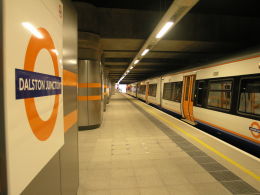Posted 24th February 2011 | 1 Comment
New East London link to open on Monday

A NEW link in London Overground’s East London Railway is to open to passengers on Monday (28 February). A reinstated curve north of the new station at Dalston Junction will mean that trains from West Croydon or Crystal Palace will then be able to run through to Highbury.
The East London Railway includes the former London Underground East London line between New Cross and Shoreditch, plus a reinstated section between Shoreditch and Dalston Junction. This was originally the route of the North London Railway into Broad Street, the terminus which used to be alongside Liverpool Street but which was demolished in the late 1980s to make way for the Broadgate Development.
Most of the modernised East London Railway was opened by Transport for London last year, but work was still outstanding on the disused western chord which links Dalston Junction with the present-day North London Railway route between Richmond and Stratford.
This chord will now open during the day on Monday, after a launch ceremony, completing the East London Railway.
Trains will then run from the ELR on to the North London Railway as far as Highbury and Islington, where passengers will be able to change to other services, including the Victoria line.
There are more plans still in the pipeline. A project is under development to extend ELR trains from a junction near Surrey Quays across south London to Clapham Junction via Denmark Hill and Brixton, which would complete London Overground’s ‘Outer Circle’.
Much of this route already exists and is used by other National Rail services, but some new infrastructure would be needed to make the connection from Surrey Quays.
Reader Comments:
Views expressed in submitted comments are that of the author, and not necessarily shared by Railnews.

Hugh Collins, Ealing, England
Great News! The network is gradually reclaiming the connections it had many years ago, but with better interchanges.
How about completing the extensions to the Northern Line which were abandoned in 1954, though considerable investmant had been made?